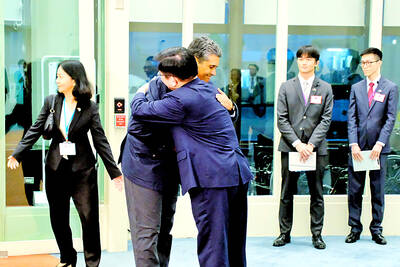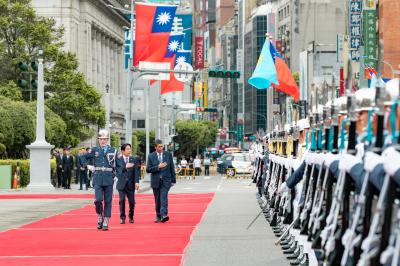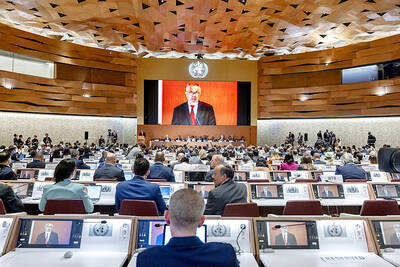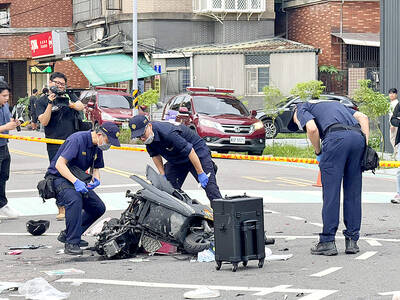While the Chinese Nationalist Party (KMT) government has said that the recently signed cross-strait Economic Cooperation Framework Agreement (ECFA) is in line with the spirit of the WTO, academics say that based on the world body’s rules and regulations, this may not be true.
On June 29, the KMT-led government, via a semiofficial government body, concluded the signing of the ECFA with China in the Chinese city of Chongqing.
The deal aims to lower tariffs on two-way trade and ease mutual market access restrictions on some service sectors on the “early harvest” list in three phases over two years. The deal will likely take effect early next year.
In an effort to substantiate its remarks that the deal was signed “under the aegis of the WTO,” the government has said it will notify the WTO about the ECFA after both sides agree on an English version of the signed deal.
China hasn’t revealed whether it will comply with the notification requirement imposed on WTO members engaging in bilateral or regional free trade agreements (FTAs).
Pessimistic about the chance of China sending a notification about the ECFA to the WTO, Chou Hui-wan (卓慧菀), an associate professor at the Graduate Institute of International Politics at National Chung Hsing University, said the government “must deliver on its promise to notify the WTO.”
“The move at least showed that we [Taiwan] viewed the ECFA as a deal signed by [Taiwan and China as] WTO members, and not as two sides of the [Taiwan] Strait, even though it is not for [Taiwan] to say the ECFA is under the WTO framework,” Chou said.
Citing the Closer Economic Partnership Arrangement (CEPA) signed in 2003 between China and Hong Kong, both WTO members, Chou said the CEPA was never considered a treaty between two countries, even if it met the WTO notification requirement.
To ensure individual regional agreements between WTO members comply with WTO standards, the WTO in 1996 created the Committee on Regional Trade Agreements (CRTA) to examine and oversee trade deals. However, it has proved to be practically non-functional.
According to WTO rules, the CRTA review for FTAs under Article 24 of the General Agreement on Tariffs and Trade (GATT) is mandatory, while review of FTAs covering trade in services under Article 5 of the General Agreement on Trade in Services (GATS) is optional.
Exemptions from the CRTA review can only be made when the agreements fall under the “enabling clause,” the legal basis for regional arrangements among developing countries that provides a waiver from most-favored nation (MFN) obligations.
Whether the ECFA was signed under Article 24 of GATT, Article 5 of GATS or based on the “enabling clause” is not clear because there is no text in the ECFA to clarify the pact’s legal basis.
The ECFA was designed in such a way that President Ma Ying-jeou’s (馬英九) administration and the Chinese authority can “operate in the gray area between a [normal] FTA and CEPA,” said Hsu Chung-hsin (�?H), a law professor at National Cheng Kung University.
Hsu pointed to two significant differences between a normal FTA and the CEPA.
The first is that it is clearly written into an FTA that it falls under GATT Article 24 or GATS Article 5, as seen in the US-Singapore FTA, while the CEPA describes its legal basis in a vague way as being “consistent with the rules of the WTO,” he said.
Secondly, Hsu said the WTO Agreement on Safeguards is normally incorporated into FTAs, again the US-Singapore FTA is an example, while the CEPA prohibits anti-dumping and countervailing measures, WTO-sanctioned trade policies.
Under these two criteria, the ECFA resembles the CEPA more than an interim agreement that would lead to the formation of a custom union or an FTA within a reasonable length of time, Hsu said.
The ECFA makes no mention of GATT Article 24 or GATS Article 5, and uses language that “it is in accordance with the basic principle of the WTO,” as the CEPA did.
Regarding trade remedy measures, Taiwan and China agreed in the ECFA that whether WTO safeguard mechanisms can be utilized “would be discussed six months after the implementation of the agreement.”
Presumably the ECFA is defined as an interim agreement to an FTA under GATT Article 24, which requires a “plan and schedule” for the formation of an FTA under which duties and other restrictive commercial regulations must be eliminated on substantially all trade.
“Inclusion of ‘plan and schedule’ for further liberalization is a requirement for an interim agreement [to comply with GATT Article 24],” said Honigmann Hong (洪財隆), an adjunct assistant professor of economics at Center for Contemporary China of National Tsing Hua University.
An “Understanding” on the interpretation of the article stipulated that the reasonable length of time for an interim agreement to form an FTA shall exceed ten years only in exceptional cases.
“According to the Understanding, it’s fine if the contracting parties of an interim agreement said it would take more than 10 years, say 15 years, for an FTA to enter into force, but they still need to give the WTO and non-party WTO members a ‘plan and schedule,’” Hong said.
Hong found that the lack of a “plan and schedule” was the biggest thing keeping the agreement from WTO compliance.
“Even the CEPA and the Framework Agreement on Comprehensive Economic Cooperation between ASEAN and China, under the ‘enabling clause,’ have a plan and schedule included,” he said.
Currently, the ECFA is only available in Chinese with both simplified and traditional characters.
The academics all agreed that it was rare for two countries to sign an agreement without simultaneously coming up with a version of the accord in a third language.
The language issue was another “trick played by China” to hint that the ECFA was more like an internal deal than an international agreement, Chou said.
“In this regard, the ECFA again follows the CEPA model,” Chou said.
China and Hong Kong submitted a joint notification on the CEPA to the WTO in 2003, with the English translation of the CEPA text posted on WTO Web site; and it was noted that the Chinese text of the CEPA would prevail as it was signed in the Chinese language.
It’s believed that an English version of the agreement will not be released before the original copy clears the KMT-dominated legislature, by the end of next month at the latest, leaving some observers concerned that the conversion would be done without oversight.
Some critics said this would allow considerable leeway for the government to manipulate the interpretation of the ECFA.
At a Ministry of Foreign Affairs meeting on Monday to brief diplomatic envoys to Taiwan on the ECFA, some concerns on the impacts of the deal were raised.
Jasmine Elise Huggins, Ambassador of St Kitts and Nevis to Taiwan, asked whether Taiwan would still go to the WTO to resolve disputes with China after the ECFA is implemented.
Mainland Council Affairs Vice Chairman Chao Chien-min (趙建民) said that both sides could choose either the WTO Dispute Settlement Mechanism (DSM) or a to-be-established platform under the ECFA framework.
Chao’s answer was inconsistent with the ECFA text, which says that disputes shall be dealt with bilaterally.
“Once WTO members enter into a regional trade agreement, the WTO DSM would no longer be applicable, which was exactly what China wanted [from signing the ECFA with Taiwan],” Hsu said.
The argument that disputes between Taiwan and China could still be brought to the WTO for arbitration was a “lie” to appease mounting concerns over the “lack of transparency” in regards to the ECFA and other cross-strait issues, Hsu said.
Similar concerns were raised by other envoys at the briefing.
At the briefing, the representative from Palau asked about what short-term and long-term political and economic implications the ECFA would have for countries with diplomatic relations with Taiwan.
Israel’s Representative to Taiwan Raphael Gamzou said he wondered what China’s motivation was to sign the ECFA. Muzaffer Eroktem, representative of Turkey to Taiwan, asked government officials why China kept pushing Taiwan to open its borders to Chinese investment.
Despite reassurance from the government that the ECFA is compatible with the WTO, whether this is true remains to be seen.

Palauan President Surangel Whipps Jr arrived in Taiwan last night to kick off his first visit to the country since beginning his second term earlier this year. After arriving at Taoyuan International Airport at around 6:30 pm, Whipps and his delegation were welcomed by Minister of Foreign Affairs Lin Chia-lung (林佳龍). Speaking to gathered media, the Palauan leader said he was excited and honored to be back in Taiwan on his first state visit to Taiwan since he was sworn in this January. Among those traveling with Whipps is Minister of State Gustav N. Aitaro, Public Infrastructure

President William Lai (賴清德) yesterday thanked Palau for its continued support of Taiwan's international participation, as Taipei was once again excluded from the World Health Assembly (WHA) currently taking place in Switzerland. "Palau has never stopped voicing support for Taiwan" in the UN General Assembly, the WHO and other UN-affiliated agencies, Lai said during a bilateral meeting with visiting Palau President Surangel Whipps Jr. "We have been profoundly touched by these endorsements," Lai said, praising the Pacific island nation's firm support as "courageous." Lai's remarks came as Taiwan was excluded for the ninth consecutive year from the WHA, which is being held in

RESOLUTIONS DEBATE: Taiwan’s allies said that UN and WHA resolutions cited by China and other nations ‘do not determine Taiwan’s participation in WHO activities’ A proposal to invite Taiwan to this year’s World Health Assembly (WHA) was rejected on Monday, resulting in Taipei’s absence from the annual meeting for a ninth consecutive year, although partners spoke up for Taiwan’s participation at the first day of the meeting. The first agenda item after the opening was a “two-on-two debate” on a proposal to invite Taiwan to participate at the WHA as an observer. Similar to previous years, two countries made statements in favor of the proposal, while two others expressed their opposition. Philippine Secretary of Health Teodoro Herbosa, president of the 78th WHA, accepted the WHA General Committee’s

At least three people died and more than a dozen were injured yesterday afternoon when a vehicle struck a group of pedestrians in New Taipei City’s Sansia District (三峽). The incident happened at about 4pm when a car rammed into pedestrians at an intersection near Bei Da Elementary School. Witnesses said the sedan, being driven at a high speed, ran a red light, knocking scooters out of the way and hitting students crossing the road before careening into a median near the intersection of Guocheng and Guoguang streets. The incident resulted in three deaths and 13 injuries, including the driver, a 78-year-old man